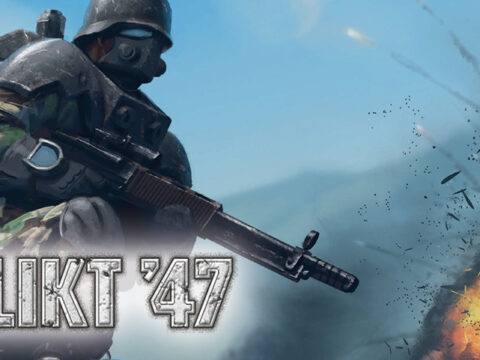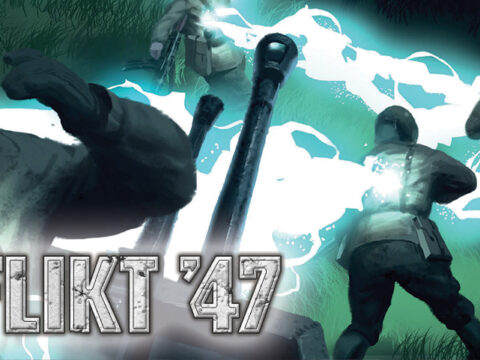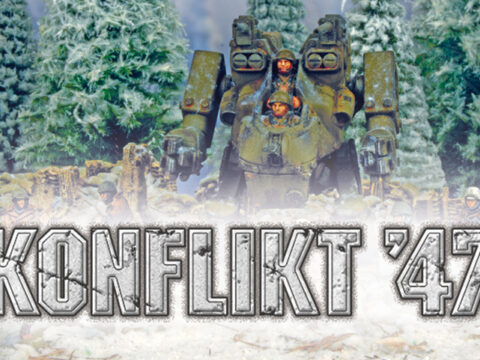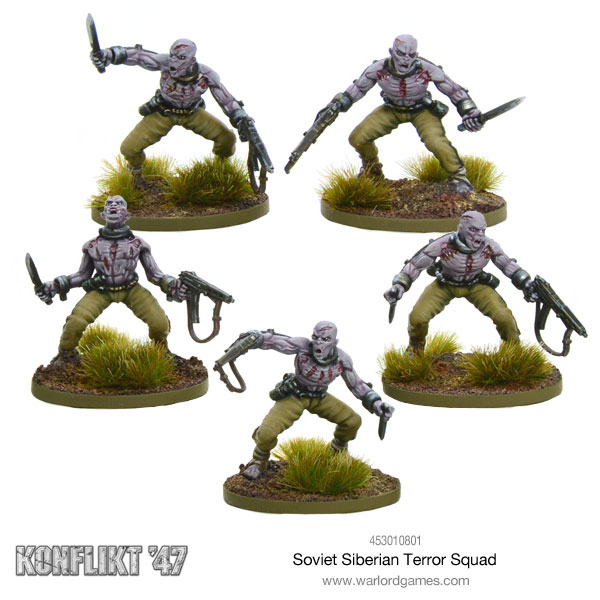Konflikt 47: Operation PIG-STICK and the Battle for Brussels
by Ben Moorhouse and Perry Bishop
PART II – SCENARIO & FORCE SELECTORS
Part I of the Battle for Brussels article series concentrated on the historical background of Operation PIG-STICK. With Part II we want to take this further and down on to the tabletop, showing how you can make some fantastic Brussels themed games for Konflikt 47. In doing so we’ve included a new battle-scenario following Allied forces as they probe into the dead-minefield, which is great fun and I’d encourage everyone to give it a go. Finally we finish with some force selectors for the period to allow players to go off and design their own battles based on the exploits of the 8th British Light Walker Brigade or US 52nd Armoured Walker Brigade – enjoy!
British riflemen rush across a dirt road during the advance to Brussels under cover from a Cromwell-T
SCENARIO: THE BATTLE FOR BRUSSELS
JULY/AUGUST 1945 – OPERATION PIG-STICK
This scenario covers the Allied assault on “Festung Brussels” as part of Operation PIG-STICK. In particular, it covers the initial Allied advance into the outskirts of the Totes Minenfeld (Dead minefield).
Lacking the requisite combat power to cover all of their obstacle belt from fixed positions, in these outer areas and suburbs of Brussels, the Germans are employing mobile all-arms groups to harass and counter-attack any Allied incursions into the city.
The Allied column must advance rapidly through the minefield to maintain the drive towards Brandenberger’s Headquarters, whilst preserving its combat power. The German defender’s aim is to disrupt the Allied advance in order to allow its eventual defeat once within range of the main Brussels fortifications.
FORCES
For this scenario, the German player, representing the mobile counter-attack force covering the minefield, should select a force up to 500pts in value. They may assemble their units from a standard reinforced platoon list or from the German Battle for Brussels theatre selector. Being a mobile force, all supporting artillery and anti-tank guns must have transport. No Totenkorps may be selected, instead a pool of Totenkorps is put aside to represent the minefield (made up of as many models as you own, 16 is an ideal number) as well as 4 orders dice of a different colour, these represent the minefield activations. All German forces (less Totenkorps) start the game in reserve (see Reserves the in main rulebook p122).
The Allies field a force of 1000pts from either the reinforced platoon list or the Allied Battle for Brussels force selector. All supporting artillery and anti-tank guns must have transport.
Points values are a guide only and can be adjusted at players’ discretion. However, please remember to adjust the Totenkorps pool and dice accordingly.
TERRAIN
As this scenario represents the entry of Allied forces into Brussels and their subsequent fight-through, terrain should be of an appropriate ‘built-up’ nature consisting of city streets, ruined buildings, and general urban construct. To compensate for the dense terrain setup, it is recommended that the battle be fought on a 4x4ft table. As many players may not have access to enough buildings to cover a 4×4, the scenario could be played on a greener board representing suburbs or city park as an alternative option.
SET-UP
If the terrain setup does not dictate the attacker and defender edges, the German player picks a side of the table as his entry edge, the Allied player taking the opposite edge.
DEPLOYMENT
As all of the German player’s units are in reserve there is no initial setup for them. Consequently, no orders dice are placed in the bag on turn 1 for his main force. However, his four minefield dice are placed in the orders bag at the start of turn 1. There is no hidden set-up or forward deployment for the German player’s units (see Hidden Set-Up in the main rulebook p120).
The attacker’s units are not set up on the table at the start of the game. The attacker must nominate at least half of his force to form the first wave. This can be his entire army if he wishes. Any units not included in the first wave are left in reserve but these may not use the outflanking manoeuvre. As with the German forces, there is no forward deployment of observers or snipers.
SPECIAL RULES
TOTES MINENFELD
In this scenario the dead minefield is represented by the 4 additional order dice (of a different colour to those of the Allies or Germans) which are placed in the bag at the start of turn 1. Each time a minefield die is drawn from the bag the German player must either activate an existing Totenkorps squad on the board or bring a new squad into play. Each minefield squad consists of 4 models.
The maximum number of deployed Totenkorps squads at any one time cannot exceed the total number of minefield order dice. At the end of the turn all minefield orders dice are returned to the orders bag including those from destroyed squads, in this way the Totenkorps continually recycle. There can be no more squads of Totenkorps on the board than there are orders dice at any one time. When a Totenkorps squad is destroyed, a second orders dice cannot be used to immediately bring it back on the same turn!
When deploying a minefield squad the unit may be placed anywhere on the board so long as it is at least 12” distant from any Allied unit. Once placed the squad can then be given an order as per normal.
The Dead-Minefield converges on an Allied defensive position held by a pair of British Automatons
OBJECTIVE
The Allies must try to progress across the table conserving as much of their force as possible. The Germans must either delay or halt the column to blunt the Allied advance.
FIRST TURN
The battle begins. During turn 1 the Allied player must bring onto the table any forces not in reserve, representing the head of the Allied column. These units can enter the table from any point on the Allied table edge, and must be given either a run or advance order. Note that no order test is required to move units onto the table as part of the first wave.
GAME DURATION
Keep a count of how many turns have elapsed as the game is played. At the end of turn 8, roll a die. On a result of 1, 2 or 3 the game ends, on a roll of 4, 5 or 6 play one further turn. The game will also end if there are no longer any Allied units left on the table at any time.
VICTORY!
At the end of the game calculate which side has won by adding up victory points as follows:
The German player scores 1 victory point for every Allied unit destroyed.
The Allied player scores 1 victory point for each of their own units that leave the battle off the German table edge before the end of the game.
If one side scores at least 2 more victory points than the other, then that side has won a clear victory. Otherwise the result is deemed too close to call and honours are shared – a draw!
OPTIONAL RULE – To change up the scenario slightly and to reduce the difficulty for the Allied player, if required, reduce the Totenkorps dice pool by one for every Allied unit that leaves play via the German table edge.
British Cromwell-T and Daimler Dingo Scout Car during a forward reconnaissance into the Brussels suburbs
THEATRE SELECTORS: THE BATTLE FOR BRUSSELS
JULY/AUGUST 1945 – OPERATION PIG-STICK
The following Allied and German theatre selectors represent the forces available to both sides during Operation Pig-Stick and may be taken over the standard reinforced platoon in the main rulebook when re-fighting the Battle for Brussels.
GERMANY
A German force representing the defenders for “Festung Brussels” must compromise of one or more reinforced platoons picked from the following Theatre Selector. Each reinforced platoon is made up as follows:
| FESTUNG BRUSSELS REINFORCED PLATOON | |
| 1 | Leutnant or Oberleutnant |
| 2 | Infantry Squads: Wehrmacht Infantry squad, Waffen-SS, Fallschrimjager or Veteran Infantry squad |
| PLUS | |
| Headquarters | |
| 0-1 | Hauptmann or Major (per force not platoon) |
| 0-1 | Medic or specialist medic team |
| 0-1 | Forward Observer (either Artillery or Air) |
| Infantry | |
| 0-4 | Infantry Squads: Wehrmacht Infantry squad, Waffen-SS, Fallschrimjager or Veteran Infantry squad, Wehrmacht Heavy Infantry squad, Fallschrimjager Falcon Squad, Waffen-SS Shocktrooper squad, Totenkorps squad, Shrekwulfen squad or Nachtjaeger Assault squad |
| 0-2 | MMG teams |
| 0-1 | Mortar team: light, medium or heavy |
| 0-2 | Panzerschreck or heavy Panzerschreck anti-tank team |
| 0-1 | Sniper or heavy sniper team |
| 0-1 | Flamethrower team |
| Artillery | |
| 0-1 | Gun from: |
| Anti-tank gun: Panzerbuchse 41, PaK 40, PaK 43 | |
| Artillery gun: Light, Medium, Heavy, Nebelwerfer or Recoilless Artillery | |
| Armoured Cars and Light Walkers | |
| 0-1 | Vehicle from: |
| Armoured Car or Recce vehicle: SdKfz 222, SdKfz 234 (all variants), SdKfz 250/9 or 250/10 | |
| Light walker: Spinne, Flammspinne | |
| Tanks, Tank Destroyers, Self-Propelled Artillery, Anti-Aircraft Vehicles and Medium & Heavy Walkers | |
| 0-1 | Vehicle from: |
| Tank: Panzer IV, Panzer IV X, Panther, Tiger I, Tiger II | |
| Tank Destroyer: StuG III/IV, Jagdpanzer IV, Jagdpanther, Jagdtiger, Hetzer | |
| Self-Propelled Artillery: Wespe, Hummel, Strumhaubitze 42, Panzerwerfer 42 | |
| Anti-Aircraft Vehicle: Flakpanzer IV, SdKfz 7 Flak | |
| Medium and Heavy Walker: Nil | |
| Transports and Tows | |
| 0-1 | Transport vehicle per infantry unit in the reinforced platoon from: SdKfz 251/1, SdKfz 250/1, SdKfz 7, Truck, Maultier, Kübelwagen, Schwimmwagen, a max of one SdKfz 251/10 or 251/17 |
| 0-1 | Tow from: SdKfz 7, Truck, Maultier |
A British Artillery Observer calls down an artillery barrage on German Totenkorps forces
ALLIES
An Allied force for Operation Pig-Stick must compromise of one or more reinforced platoons picked from the following Theatre Selector. US forces represent the 52nd US Armoured Walker Brigade (the “Hell Knights”), and British, the 8th British Light Walker Brigade. Working closely together an Allied force could consist of two reinforced platoons, one from each brigade. Each reinforced platoon is made up as follows:
| OPERATION PIG-STICK REINFORCED PLATOON | |||
| 52nd US Armoured Walker Brigade | 8th British Light Walker Brigade | ||
| 1 | Officer | Second or First Lieutenant | Second or First Lieutenant |
| 2 | Infantry Squads | Infantry squad, Ranger or Airborne Infantry squad | Infantry section, Commando, Royal Marines, Airborne Infantry section, Inexperienced Infantry section |
| PLUS | |||
| Headquarters | |||
| 0-1 | Officer | Captain or Major (per force not platoon) | |
| 0-1 | Medic team | Medic | |
| 0-1 | Forward Observer | Forward Observer (either Artillery or Air) | |
| Infantry | |||
| 0-4 | Infantry Squads | Heavy Infantry squad, Infantry squad, Ranger or Airborne Infantry squad, Heavy Infantry squad, Firefly Jump Infantry squad, | Infantry section, Commandos, Royal Marines, Airborne Infantry section, Inexperienced Infantry section, Automated Infantry squad |
| 0-1 | MMG teams | .30 cal MMG or .50 cal HMG team | MMG team |
| 0-1 | Mortar team | Light, medium or heavy | Light, medium or heavy |
| 0-1 | Anti-tank team | Bazooka or heavy bazooka team | Anti-tank rifle or PIAT team |
| 0-1 | Sniper team | Sniper team | Sniper team |
| 0-1 | Flamethrower team | Flamethrower team | Flamethrower team |
| Artillery | |||
| 0-1 | Gun from: | ||
| Anti-tank gun | 37mm, 57mm, 3-inch | QF 6 Pdr, QF 17 Pdr | |
| Artillery gun | Light, medium, heavy, recoilless | Light, medium, heavy | |
| Armoured Cars and Light Walkers | |||
| 0-2 | Vehicle from: | ||
| Armoured Car or Recce vehicle | M8 Greyhound, M20 Scout Car | Scout Car, Light Armoured Car, Automated Carrier, M8 Greyhound, Staghound Mk I | |
| Must include at least 1: | |||
| Light walker | M5A2 Coyote, M5A5/6 Jackal | Coyote, Guardian | |
| Tanks, Tank Destroyers, Self-Propelled Artillery, Anti-Aircraft Vehicles and Medium Walkers | |||
| 0-2 | Vehicle from: | ||
| Tank | M5A1 Stuart, M24 Chafee, M4A3 Sherman, M4A9 Sherman-T, M26 Pershing | M5 Stuart, M24 Chafee, Cromwell, Cromwell-T, Challenger, Comet, Sherman, Churchill, Churchill Crocodile | |
| Tank Destroyer | M10, M18 Hellcat, M36 Jackson | M10 Achilles, Archer | |
| Self-Propelled Artillery | M7 Priest, M12 Gun Motor Carriage, M21 Mortar Carrier | M7 Priest, Sexton, Wasp Flamethrower Carrier | |
| Anti-Aircraft Vehicle | M16 Anti-Aircraft Carriage | Crusader AA, Staghound AA | |
| Must include at least 1: | |||
| Medium Walker: | M8 Grizzly, M8A4 Ursus, M9A2 Kodiak, M2 Mudskipper | Grizzly | |
| Transports and Tows | |||
| 0-1 | Transport vehicle per infantry unit in the reinforced platoon from: | ||
| 2½ Ton Truck, Jeep, Dodge ¾ ton, M3 Half-track | Truck, Jeep, M5 Half-track, Bren Carrier | ||
| 0-1 | Tow from: | 2½ Ton Truck, Jeep, Dodge ¾ ton, M4/M5 Tractor, M3 Half-track | Truck, Jeep, M5 Half-track, Bren Carrier |
Starter Sets to get started!
The best approach to get into Konflikt’47 is to find your army of choice a pick up a starter set. Each is focussed on a specific army and provides the basic requirements for any force plus the rules. Then, on top of these sets, you’ll easily be able to expand with the many options, which are being added to all the time, in the Konflikt’47 collection…
German Starter Set:
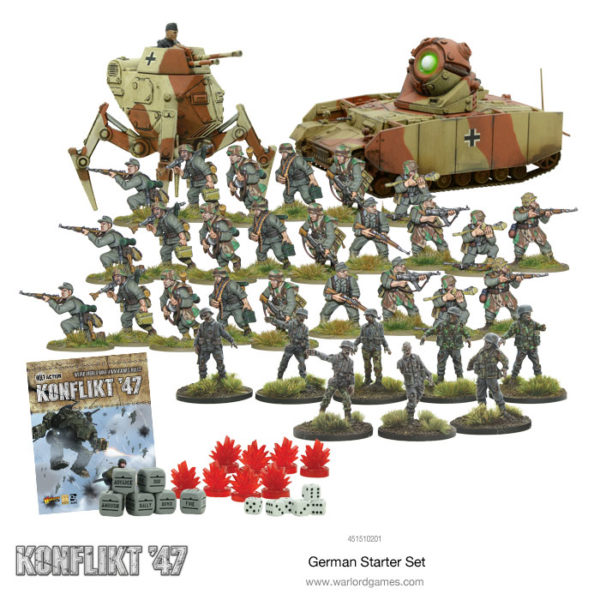
Soviet Starter Set:
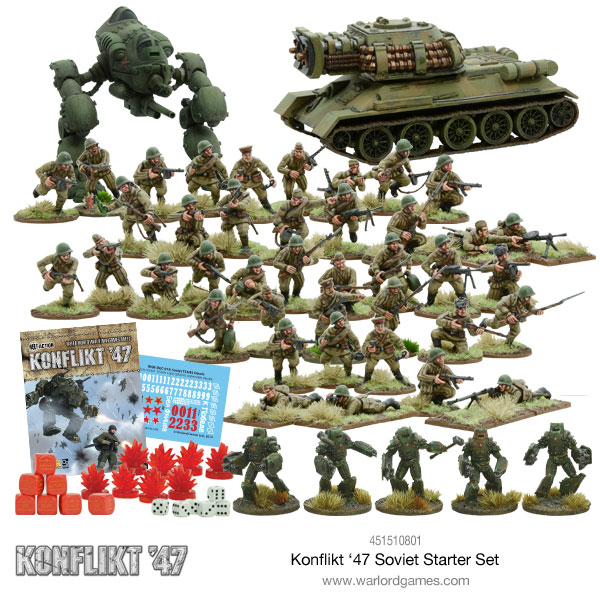
British Starter Set:
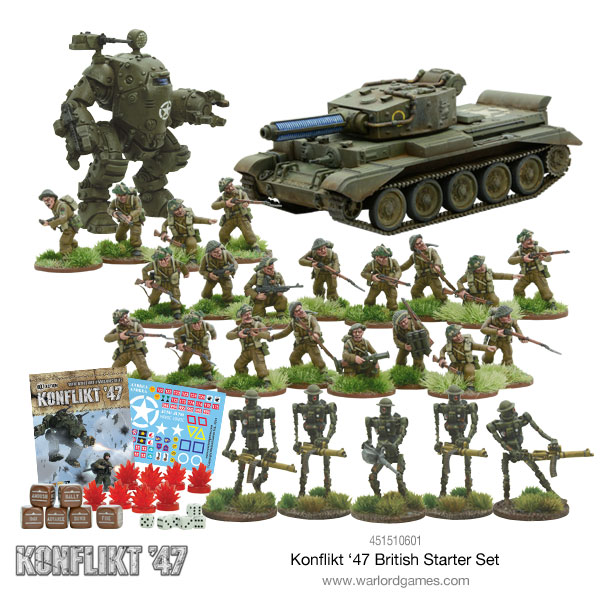
US Starter Set:
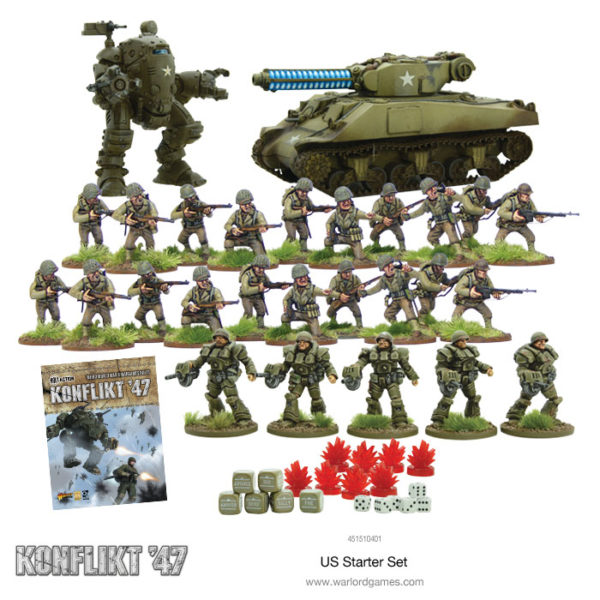
Japanese Starter Set:
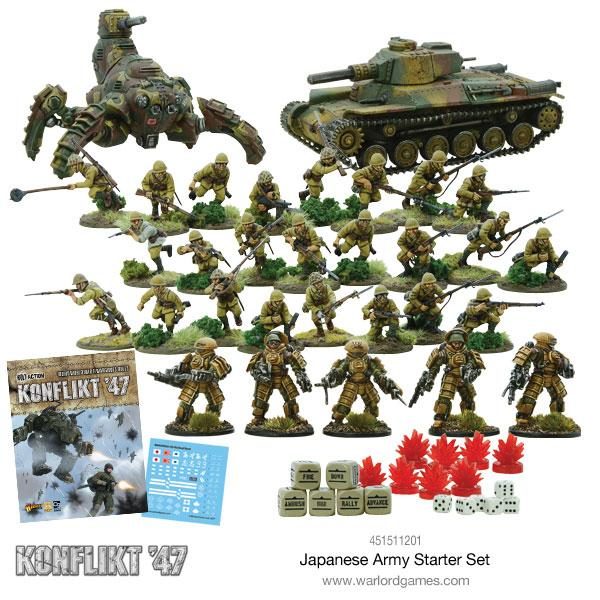
Finnish Starter Set:
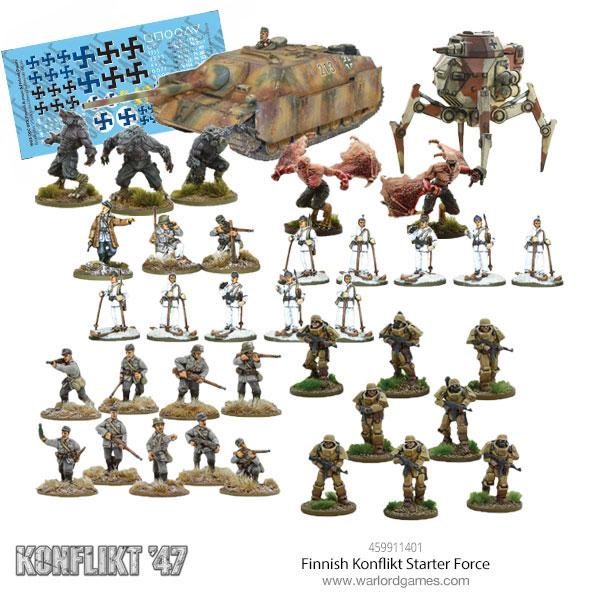
So onward commander, choose your force and see if you will prevail on as World War II continues into 1947 and beyond!
Do you have an article within you? Are you itching to show your collection to the world? Then drop us a line with a couple of pictures to info@warlordgames.com or share with all over at the Warlord Facebook page





